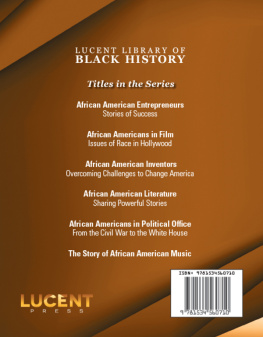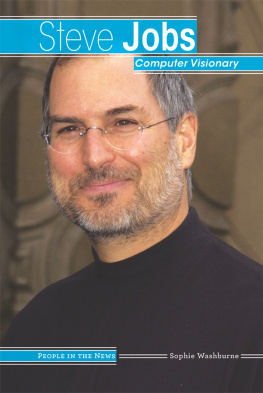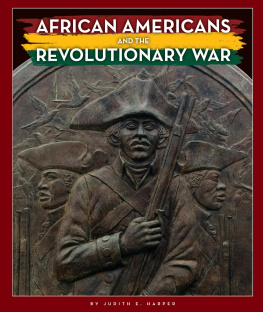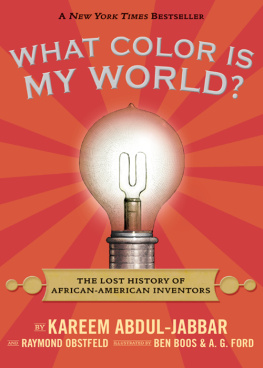Published in 2018 by
Lucent Press, an Imprint of Greenhaven Publishing, LLC
353 3rd Avenue
Suite 255
New York, NY 10010
Copyright 2018 Greenhaven Press, a part of Gale, Cengage Learning
Gale and Greenhaven Press are registered trademarks used herein under license.
All new materials copyright 2018 Lucent Press, an Imprint of Greenhaven Publishing, LLC.
All rights reserved. No part of this book may be reproduced in any form without permission in writing from the publisher, except by a reviewer.
Designer: Deanna Paternostro
Editor: Siyavush Saidian
Library of Congress Cataloging-in-Publication Data
Names: Washburne, Sophie, author.
Title: African American inventors : overcoming challenges to change America / Sophie Washburne.
Description: New York : Lucent Press, [2018] | Series: Library of Black history | Includes bibliographical references and index.
Identifiers: LCCN 2017004227 (print) | LCCN 2017008805 (ebook) | ISBN 9781534560710 (library bound book : alk. paper) | ISBN 9781534560727 (eBook)
Subjects: LCSH: African American inventors--Juvenile literature. | Inventions--United States--Juvenile literature.
Classification: LCC T39.W37 2018 (print) | LCC T39 (ebook) | DDC 609.2/396073--dc23
LC record available at https://lccn.loc.gov/2017004227
Printed in the United States of America
CPSIA compliance information: Batch #BS17KL: For further information contact Greenhaven Publishing LLC, New York, New York at 1-844-317-7404.
Please visit our website, www.greenhavenpublishing.com. For a free color catalog of all our high-quality books, call toll free 1-844-317-7404 or fax 1-844-317-7405.
CONTENTS
Foreword
Setting the Scene: A Timeline
Introduction:
A History of Innovation
Chapter One:
Pre-Civil War Black Inventors
Chapter Two:
Mechanical Experimentation and the Industrial Revolution
Chapter Three:
Electric America
Chapter Four:
Progress in the 20th Century
Chapter Five:
Changing Attitudes, Changing Technology
Notes
For More Information
Index
Picture Credits
About the Author
FOREWORD
B lack men and women in the United States have become successful in every field, but they have faced incredible challenges while striving for that success. They have overcome racial barriers, violent prejudice, and hostility on every side, all while continuing to advance technology, literature, the arts, and much more.
From medicine and law to sports and literature, African Americans have come to excel in every industry. However, the story of African Americans has often been one of prejudice and persecution. More than 300 years ago, Africans were taken in chains from their home and enslaved to work for the earliest American settlers. They suffered for more than two centuries under the brutal oppression of their owners, until the outbreak of the American Civil War in 1861. After the dust settled four years later and thousands of Americansboth black and whitehad died in combat, slavery in the United States had been legally abolished. By the turn of the 20th century, with the help of the 13th, 14th, and 15th Amendments to the U.S. Constitution, African American men had finally won significant battles for the basic rights of citizenship. Then, with the passage of the groundbreaking Civil Rights Act of 1964, many people of all races began to believe that America was finally ready to start moving toward a more equal future.
These triumphs of human equality were achieved with help from brave social activists such as Frederick Douglass, Martin Luther King Jr., and Maya Angelou. They all experienced racial prejudice in their lifetimes and fought by writing, speaking, and peacefully acting against it. By exposing the suffering of the black community, they brought the United States together to try to remedy centuries worth of wrongdoing. Today, it is important to learn about the history of African Americans and their experiences in modern America in order to work toward healing the divide that still exists in the United States. This series aims to give readers a deeper appreciation for and understanding of a part of the American story that is often left untold.
Even before the legal emancipation of slaves, black culture was thriving despite many attempts to suppress it. From the 1600s to the 1800s, slaves developed their own cultural perspective. From music, to language, to art, slaves began cultivating an identity that was completely unique. Soon after these slaves were granted citizenship and were integrated into American society, African American culture burst into the mainstream. New generations of authors, scholars, painters, and singers were born, and they spread an appreciation for black culture across America and the entire world. Studying the contributions of these talented individuals fosters a sense of optimism. Despite the cruel treatment and racist attitudes they faced, these men and women never gave up, changing the world with their determination and unique voice. Discovering the triumphs and tragedies of the oppressed allows readers to gain a clearer picture of American history and American cultural identity.
Here to help young readers with this discovery, this series offers a glimpse into the lives and accomplishments of some of the most important and influential African Americans across historical time periods. Titles examine primary source documents and quotes from contemporary thinkers and observers to provide a full and nuanced learning experience for readers. With thoroughly researched text, unique sidebars, and a carefully selected bibliography for further research, this series is an invaluable resource for young scholars. Moreover, it does not shy away from reconciling the brutality of the past with a sense of hopefulness for the future. This series provides critical tools for understanding more about how black history is a vital part of American history.
SETTING THE SCENE: A TIMELINE
INTRODUCTION
A HISTORY OF INNOVATION
D espite using an uncountable number of important inventions every single day, few Americans are able to name many inventors. In fact, most people do not consider many everyday items to even be inventions. Most people could say that Wilbur and Orville Wright were the inventors of the airplane, because their invention has altered the very foundations of modern daily life. However, barely anyone can give as much information about other common items. Regardless of the vast improvements made to everyones quality of life with each new invention, people generally do not care about the men and women who worked diligently to create them. This has been true for centuries.
Though few inventors get the credit they deserve, the stories of their technological innovationsand how they created themare some of the most interesting in history. There is a proverb that has been used for hundreds of years: Necessity is the mother of invention. It means that when something really needs to be improved, some great thinker or creator will come up with a new method of doing it. People needed to travel faster, leading to the invention of the airplane; people needed more efficient and effective light, leading to Thomas Edisons invention of the light bulb. There have been thousands of crucial inventions throughout the course of history, and every single one of them has an interesting story behind it. By investigating the need that prompts someone to become an inventor, it is possible to learn more about them, their time period, and the importance of their invention itself.
















